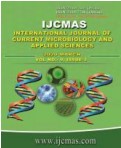


 National Academy of Agricultural Sciences (NAAS)
National Academy of Agricultural Sciences (NAAS)

|
PRINT ISSN : 2319-7692
Online ISSN : 2319-7706 Issues : 12 per year Publisher : Excellent Publishers Email : editorijcmas@gmail.com / submit@ijcmas.com Editor-in-chief: Dr.M.Prakash Index Copernicus ICV 2018: 95.39 NAAS RATING 2020: 5.38 |
L-asparaginase acts as an efficient agent in curing certain sorts of lymphoma and leukemia by catalyzing the deamination of L-asparagine to L-aspartate and ammonia. Microorganisms are better source of L-asparginase, as their culturing, extraction and purification is more convenient than plants and other sources. As most of L-asparginases are intracellular in nature, so the selection of a suitable method for its release with maximum recovery was become more important. In present study, the resting cells of S. marcescens MTCC 97 were disintegrated by different enzymatic (lysozyme), chemical (alkali lysis, acetone powder, guanidine-HCl and triton X-100) and physical (motor and pestle, vortex, bead beater and sonicator) methods. Among all methods explored, sonication was found best method with 0.05 U/mg specific activity and minimum loss of enzyme (8%). Different reaction parameters were also optimized for the characterization of released L-asparginase. The extracted L-asparaginase showed maximum activity (0.985 U/ml) in 0.05M sodium phosphate buffer (pH 7.5) with L-asparagine (8mM) as substrate at 40oC incubation for 20 min. Moreover, different metal ions, additives, chelating agents and protease inhibitors showed negative effects on L-asparaginase activity of resting cells and cell free extract obtained from S. marcescens MTCC 97.
 |
 |
 |
 |
 |